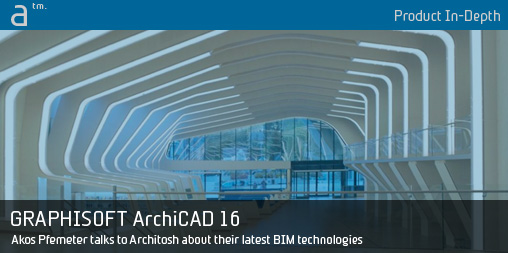Continued from page 3
Graphisoft’s Technological Vision
As it was in the beginning Graphisoft is an “architect’s” software company, creating a BIM software platform oriented directly at the architectural professional. This focus continues in version 16. Graphisoft has its emphasis on three separate solutions areas. The first area is BIM authoring which centers on ArchiCAD. The second area is BIM data management with the BIM Server. And the third area is BIM data access, which addresses the cloud and mobile.
What they have done with BIMcomponents.com is take advantage of both cloud computing trends and the social Web. The technology behind BIMcomponents.com is Microsoft Windows Azure and Microsoft DynamicsNav. This technology backbone will help the company extend both the cloud component and the mobile component. “With the cloud,” says Pfemeter, “we will provide custom offerings for clients.” “Additionally, to extend our mobile platforms we will be coming out with BIMx for Android as well.
Pfemeter said Graphisoft’s approach to the cloud is similar to Apple’s. “We want to keep core functionality in the thick client,” said Pfemeter. “This is pretty similar to Apple’s iCloud approach, trying to keep the cloud quite silent in the background…be it desktop, iPad or iPhone.”
In terms of BIM data management the company is advancing its industry-leading BIM server technologies. There is now a unified format for server-side backups and regular backups in PLN format. The improved data safety also includes non-project data backups like “users” and “roles” and the inclusion of even external locations for all backups.

12 - Some of the remarkable advanced form making possible in the new ArchiCAD 16. (image courtesy Graphisoft)
“One of the benefits of what we are doing is creating frequent backup strategies for different disaster levels,” said Pfemeter, “such as project error, server software error and the server computer itself.” We will be backing up everything.
“Our delta server technology in Graphisoft BIM Server is already proved to be the most advanced in the industry for real-time collaboration,” said Pfemeter. The company has some far-reaching plans for its server technology but isn’t ready to share those plans just yet.
Closing Thoughts
We have not touched on every item new in ArchiCAD 16 but these issues discussed above are the big ones. Clearly the company is very committed to interoperability and you can read more about their OPEN BIM movement and support here. In terms of productivity there is a slew of new capabilities. There are for instance new improvements to the library of elements. Libraries are organized in the software. There are a lot of 3D user interface interaction improvements which go hand and glove with the new Morph Tool.
In our view perhaps the biggest thrust in the changes to ArchiCAD 16 center around the new “direct modeling” capabilities. In our BIM 2010 Survey Report here at Architosh “better design” was the aspect about BIM adoption that most appealed to architects, over “virtualization”, “faster documents”, “visualization”, “anti-drafting” and finally “democratization” within the studio. It was “virtualization” and the ability to test and simulate within BIM models that secondly most interested architects about 3D BIM versus 2D drafting.
From this vantage point we see the new Morph Tools following up on the recent other modeling improvements with ArchiCAD truly timely. Moreover, its integration of EcoDesigner further fosters testing and simulation as part of practice and the goals of making more credible good architectural design. This is why ArchiCAD 16 won AIA Best of Show for the Desktop category.
One of the more stunning realities behind Graphisoft as well is this little known fact. Those new Morph Tool modeling capabilities–like the rest of the program–are built on top of its own home-grown 3D geometry modeling kernel. We learned about this back when the company introduced MEP Modeler. Advancing a geometry kernel by yourself is tough work, and it’s a testament to just how advanced this company’s software prowess really is. —- ANTHONY FRAUSTO-ROBLEDO, AIA, LEED AP




Reader Comments
Comments for this story are closed